| |
Political
upheaval in the Near East delayed the 2006 WAHO Conference from last September
to April of 2007 - but delegates without exception voted it worth the
wait. The welcome in Damascus and throughout Syria overwhelmed us. The
kindness and tolerance shown throughout our visit echoed the Islamic saying:
"the Guest is a gift from God."
The British breeders there particularly appreciated the
opportunity to follow in the footsteps of Lady Anne and Wilfrid Scawen
Blunt. They scoured this treasure trove of Arabian blood to secure foundation
horses for their stud at Crabbet Park almost 130 years ago. The French,
Hungarians, Poles, Spaniards and Americans have equal reason to be grateful
for the heritage of Syria's desert-bred horses which formed the foundations
of so many breeding programmes, both national and private.
| Then as now, the purity
of the Arabian pedigree is paramount. As we heard during one illuminating
lecture, the treasured pedigree document called the "hujjah"
records both the line and the tribal ownership. It is valued highly
by native breeders. The Syrian Arab Registry has been among the most
stringent in researching pedigrees, even when desert-bred. Once accepted,
a horse is branded on the neck. |
|
 |
We had an opportunity of seeing many of these horses during
the six-day post conference tour of "Bedouins, horses and culture".
It combined the major historic sites of the Roman oasis city of Palmyra,
and even larger ruins of Afamia, the horse-breeding Bedouin strongholds
around Al Qamishly, the Crusader castle of Crac des Chevaliers, the souks
and fortress of Aleppo and the ancient waterwheels on the Orontes at Hama.
 |
|
Business in the conference
hall came to an abrupt halt on the very first morning as delegates
rushed to the balcony to watch a spectacular 400-strong tide of Bedouin
horseman in tribal costume pouring down the dual carriageway outside
the Four Seasons Hotel brandishing scimitars and muskets. This historic
parade stopped traffic on both directions! |
At every venue, hosts pulled out all the stops to greet
us, from the private breeders and top class studs to the hundreds of Bedouin
owners who rode long distances to the encampments and verges along our
route to share their pride in their beloved horses. Many ridden mares
had foals running at foot and most wore colourful saddlery with tassels
and embroidered cloths, like scenes from The Arabian Nights.
Such large crowds gathered at the tents of the Tai and
Allied Tribes that we were ushered through by a thousand helping hands
to a chorus of "Merhaba, Welcome to Syria" . So many hands to
shake, so many greetings to exchange….. We could imagine just how
the Queen must feel!
Nothing like these huge gatherings had been seen before,
nor may ever again, as word spread among the tribes that visitors from
45 countries had come with one common aim - to see THEIR horses. The West
owes a huge debt of gratitude to the tribes of the region - the Anazeh,
the Tai, the Alhisinah and the Shammar especially. Their tough desert
horses have for centuries augmented and refined native European stock
and created the military charger, and of course, the English Thoroughbred.
So to see them still flourishing in their homeland was a great privilege
and an inspiration.
However, our arrival created a massacre among the local
sheep population as herds were decimated to provide succulent feasts.
At every venue, it took teams of four men apiece to carry in each giant
platter of nut-flavoured rice and fresh-killed mutton, with embedded sheep's
skulls glaring up at us - and that served just four people!
 |
|
The Conference was hosted
by the Syrian Arabian Horse Association and the Arabian Horse Office
at the Ministry of Agriculture and Agrarian Reform, under the patronage
of Syria's president Dr Bashar Al Assad. The years of unstinting enthusiasm
and energy of Basil Jadaan, chairman of SAHA, and Mr. Mohammad Al
Wadi, Director of the Arabian Horses Bureau, together with their large
teams of hard-working volunteers, sealed the success of both the conference
and the tours through this exciting crossroads of the Near East. |
They are all to be thanked and congratulated on the smooth
running of the event and the quality of all the arrangements.
Mr Adel Safar, the Minister of Agricluture, in his opening
remarks stressed how valuable the horse is to its owner, and how often
its attributes are mentioned in poetry and the Koran.
His belief that "The best place on earth is in the
saddle," was reciprocated by his audience. The Mayor of Damascus
then hosted us to an appetising lunch at the Nobalaa Palace where we had
our first taste of a baked camel milk desert. Don't scoff - Syria's cancer
rate is an eighth of that in the West, probably due in part to an inclusion
of camel milk in their diet, plus the grated kernels of apricots which
grow in abundance in this rich agricultural land.
Each day's official proceedings were sandwiched between
hospitality of the most generous nature. Sheikh Ali Aljasem Mithwid, head
of the Al Bashakem tribe, set the standard with an atmospheric recreation
of a Bedouin encampment in the sands of the old Damascus fairground, with
horses tethered to every available pole. Vast tents and even vaster quantities
of food, delivered on huge platters greeted the hundreds of guests. By
flickering firelight, riders gave individual shows of skill and swordsmanship
on horses of the most equable temperaments. I felt privileged to be given
temporary charge of a highly prized peregrine falcon who surveyed the
proceedings with a beady eye. The evening ended, as so many that were
to follow, with impromptu dancing with tribesmen in flowing robes, on
and off their horses.
|
|
|
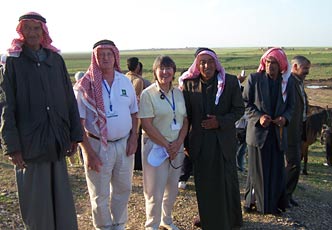 |
A concert and delicious buffet at the Asayel Alsham stud,
owned by Mr Mahmoud Al Anzarouti one evening introduced us to the skills
of Whirling Dervishes and to beautifully presented horses, including the
straight Egyptian imported stallion Ansata Haisam. The Al Khaer and Al
Jadaan Stables combined forces with Asayel Alsham to exhibit pure Syrian
horses. My favourite was Basil Jadaan's impressive black Shweimet Sabbah
mare, Al Kahirah. I was later to see her relatives at the stud of Basil's
sister, one of the finest group of mares and foals I saw in Syria.
In the moonlight, the loose mares and foals pranced around
the arena while we ate and watched the folklore show - a perfect backdrop
to an enchanting evening.
The theme of dining with horses continued in the delightful
water garden setting of the Zaman Alkhair Restaurant the following lunchtime,
courtesy of the Seif Alsham Equestrian Club and Alghabra'a Stud. The Arabian's
famed gentleness and sociability with humans came to the fore as the mares
and foals were led calmly through the pathways between the tables and
over the little bridges to greet the diners and pose for the cameras.
The gracious grey mare Ghosoon Al Thanieh, a Keheilet Armousheh, a strain
unique to Syria, stole my heart. Her influential grandsire, a Kehailan
Krush, used to be ridden from camp to camp by his owner, Joheim Al Mikhan
from the Tai tribe, to cover chosen mares.
Who could ask for more glorious company in a finer setting!
Equally impressive were the magnificent horses at Syria's
National Stud, named in honour of keen horseman and show-jumper, Basel
Al Assad, the late brother of the current president. The stud preserves
the country's 12 most important strains on a vast acreage supporting around
150 of the country's finest horses including the two stallions Majd (a
bay by Basil) and Ma'roof (a grey by Mehrez), both out of the iconic Meyadah.
Our hosts that evening - Mr Nizar Al As'ad of the Alfadi
Stud and Mr Naji Chaoui of the Aljameel Stables - arranged a unique occasion:
a banquet and lively Arabian show round the central fountain in the historic
caravanserai of Khan Asa'd Basha in the winding lanes of the old city.
In centuries past, this elegant domed mosque-like building sheltered the
camel trains crossing the region from Europe and Asia Minor en route to
Baghdad and Persia.
The next evening, Sehr Al Sharqe Stables sponsored a Gala
Dinner Dance at the Orient Club in Damascus with more fresh Syrian dishes
- palatable to all as they are not spicy - and a folklore show with the
now familiar Whirling Dervishes performing wondrous feats with layered
coloured "skirts".
| Before heading east to the
desert, we had a rare chance to hear the once important but now almost
lost language of Aramaic, which would have been spoken by Jesus. The
little church in the Christian settlement of Seydnaya was hushed as
a local lady recited the Lord's Prayer in the language his disciples
would have heard it, 2,000 years ago. |
|
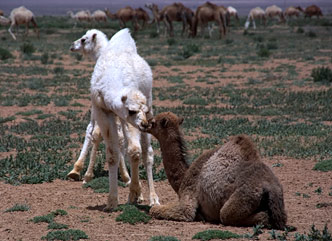 |
That evening we were treated to a horse parade, folklore
show and a delicious meal at the impressive Basel Al Assad Equestrian
and Shooting Club in Aldimas, sponsored by the Syrian Arab Horse Association
and breeders of the Damascus area. Here we saw some really athletic Arabs,
including racehorses and some fine show horses. A real treat accompanied
the fine food as ethereal mares and foals were let loose to run in the
small paddock beside our tables, like quiet ghosts moving through the
warm Syrian evening.
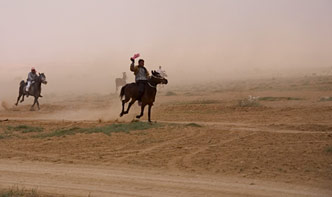 |
|
The hospitality of the Damascus
breeders proved a t tasty hors d'oeuvre to the main course - the six-day
tour combining world heritage historic sites, Bedouin camps and Open
House at private breeders' studs. The highlight for me involved a
wonderful horse race in dusty desert clouds between the Sba'a and
Fedaan clans of the Anazeh. One late-comer joined in half-way through
the race - then claimed victory. |
Before he was lynched, order was restored and the true victor carried
on the shoulders of his clansmen to claim his trophy. Many of the jockeys
rode bareback; one poor young lad on an 18-month old horse, was in the
lead but fell off almost at the finish line.
| The frisson
as we were then drawn in to the heart of the encampment, and greeted
by dozens of Bedouins in blinding white robes touched us all. The
gold edges on the robes of our hosts, Sheikh Owaidhah Alfayyadh, from
the Risaleen of the Sba'a of Anazeh, Sheikh A'asi Hilaiel al Sharekh,
from the Risaleen of the Sba'a of Anazeh, and Sheikh Abdullah Abu
Saifain, from the Fedaan of the Anazeh helped us identify them to
say "Shukran" (thank you) for their warm hospitality. |
|
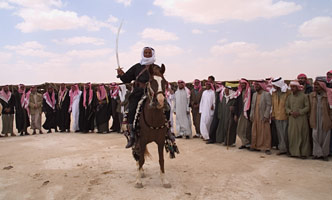 |
| |
|
|
 |
|
This scene was re-enacted
at each Bedouin camp, at the Tai, the Shammar and the Anazeh, as we
learned more about the customs of these remarkable breeders and their
precious horses. What joy they displayed in showing us their horses,
feeding us with mounds of mutton, and entertaining us with displays
of horsemanship. |
| |
|
|
| Stitching is carried out
on some mares, to prevent them being covered when away racing or competing.
Many tribes still follow the guidance of an equine match-making expert
who studies the mare's pedigree and advises on a suitable stallion.
Only when that one is available will she be mated. None of the colts
are gelded, as it is against a Koranic ruling, but only the very best
are kept for stud duties. Approved stallions used to stand at centres,
especially in Hama but also Aleppo, during the breeding season, providing
a central point for mare owners. |
|
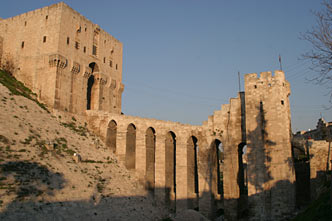 |
Now for the cruncher - a stallion owner takes no fee for
a covering. It is his duty - and honour - to allow any owner of a pure-bred
mare a service. And if a breeder sells a pure-bred mare, he will still
often require one or two fillies from her in return, as part of the deal,
to ensure the continuation of the female line.
In the past 20 or 30 years, many private studs have sprung
up with the inevitable development in just a few generations from the
small wiry desert survivor into a taller sleek show horse and athletic
prize-winning racehorse.
We enjoyed the opportunity of seeing this improved version
of the Arabian at Al Furat Stables where we were treated to a parade of
lovely horses on the banks of the Eurphates at sunset with kingfishers
diving around us. Nibal, an elegant grey 6-year old Saglawia Marzakania
was particularly impressive as she trotted between the palms.
Boats then took us to the Ganama Stables further along
the river with fine horses as the backdrop to our sumptuous buffet supper.
Here, the 6-year grey stallion Lawrence rules - but Zein a strong 8-year
old chestnut mare, obviously has great influence.
One of the youngest and keenest breeders, Omar Anbarji
invited us to the gardens of his Al Andalus Stud for another enchanting
evening of prancing horses and dancing dervishes. The vision of the wonderful
rich chestnut mare Baghdad (a Hamdaniat Al-Ofri) with long white stockings,
will live long in my memory - the prototype for so many Crabbet horses
we see in Britain today.
We appreciated that the dominant qualities of the Arabian
remain in their country of origin: gentle temperament but with that charismatic
look-at-me quality, strong bone below the knee and good limbs, excellent
angle of shoulder and length of neck, high tail carriage and kind eye.
What greater gift could Syrians bequeath the equestrian
world!
A specially commissioned DVD of the WAHO Conference and
tours made by Boston-based Syrian, Mohammed Ohjee is on sale. A short
clip of this atmospheric and unforgettable occasion and desert journey
is available at www.dragonflyproduction.net.
Warmest thanks are due to Syrian Arabian Horse Association
for hosting the conference: P.O. Box 31815 Damascus, Syria; tel +963 11
3245 385/6. E-mail: info@saha-sy.org.
I travelled with the Bradt guide to Syria by Diana Darke
(£14.99), one of the best to the region.
To illustrate the importance of purity to the Arab breeder
in Syria, the introduction to Volume 1 of the Syrian Stud Book explains:
"Lineal descent, traceable to the origin, was sacred to the Arabs,
arising from their belief that mental and physical qualities are genetically
inherited. The continuation and safety of the race depends upon the retention
and strengthening of these traits.
"This principle was adopted to ensure their future
and was applied as rigorously to the Arabian horse to safeguard its heritage.
The Arabs were proud of their horses' purity and would learn by heart
their pedigrees, keeping them as if they were their own. The Arabs were
so keen to preserve this purity that they never allowed a purebred mare
to be impregnated except by a purebred stallion, under strict conditions,
observed by the owners and trusted witnesses, even though such an act
may have had to wait for years to be performed.
"Therefore the majority of the known Arabian strains,
together with their sub-strains, are represented in Syria to this day,
such as the Keheileh, the Saglawieh, the Shweimah, the Hadbaa, the Dahmaa,
the Obayah, the Ma'anaghieh, the Hamdanieh. However the strain name alone
is not considered sufficient identification in Syria.
"Verification of the origin and purity of a mare
requires affiliation to one of these strains and also attribution to the
owner. Thus, to give just a few examples, strains found in Syria include
Saglawieh Jedranieh, Saglawieh Shaifieh, Shweimeh Sabbah, Obayah Sharakieh,
Ma'anaghieh Sbeylieh, Keheilet Ajuz Ibn Jleidan, Keheileh Da'ajanieh Kashra,
Keheilet Krush Al Baida, Hamdanieh Ibn Ghorab, Hamdanieh Semrieh, Dahmaa
Amer and so on."
A specially commissioned DVD of the WAHO Conference and
tours made by Boston-based Syrian, Mohammed Ohjee will be for sale. A
short clip of this atmospheric and unforgettable occasion and desert journey
is available at www.dragonflyproduction.net.
Details of the Syrian Arabian Horse Association are: P.O.
Box 31815 Damascus, Syria; tel +963 11 3245 385/6. E-mail: info@saha-sy.org.
The Bradt guide to Syria by Diana Darke, recently published
at £14.99, is one of the best to the region.
To illustrate the importance of purity to the Arab breeder
in Syria, the introduction to Volume 1 of the Syrian Stud Book explains:
"Lineal descent, traceable to the origin, was sacred to the Arabs,
arising from their belief that mental and physical qualities are genetically
inherited. The continuation and safety of the race depends upon the retention
and strengthening of these traits.
"This principle was adopted to ensure their future
and was applied as rigorously to the Arabian horse to safeguard its heritage.
The Arabs were proud of their horses' purity and would learn by heart
their pedigrees, keeping them as if they were their own. The Arabs were
so keen to preserve this purity that they never allowed a purebred mare
to be impregnated except by a purebred stallion, under strict conditions,
observed by the owners and trusted witnesses, even though such an act
may have had to wait for years to be performed.
"Therefore the majority of the known Arabian strains,
together with their sub-strains, are represented in Syria to this day,
such as the Keheileh, the Saglawieh, the Shweimah, the Hadbaa, the Dahmaa,
the Obayah, the Ma'anaghieh, the Hamdanieh. However the strain name alone
is not considered sufficient identification in Syria.
"Verification of the origin and purity of a mare
requires affiliation to one of these strains and also attribution to the
owner. Thus, to give just a few examples, strains found in Syria include
Saglawieh Jedranieh, Saglawieh Shaifieh, Shweimeh Sabbah, Obayah Sharakieh,
Ma'anaghieh Sbeylieh, Keheilet Ajuz Ibn Jleidan, Keheileh Da'ajanieh Kashra,
Keheilet Krush Al Baida, Hamdanieh Ibn Ghorab, Hamdanieh Semrieh, Dahmaa
Amer and so on."
Copyright Anne Brown 2007
|